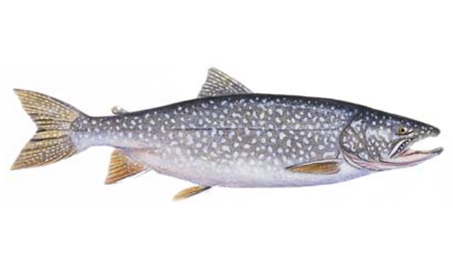Common Names: Lake trout, laker, lake char
Habitat
Lake trout are synonymous with deep, clear water. They can be found throughout most of Ontario in any lake with suitable habitat. During the summer months the fish usually inhabit the deepest parts of the lake, spending most of their time in waters deeper than 50 ft. During fall they move to shallow shoals to spawn and can, again, be found shallow in the spring.
Spawning Patterns
Spawning occurs in the fall usually during the month of October in most of its range but can be as early as September in the far north. It is suspected that both a falling water temperature and a decrease in daylight hours trigger spawning. Spawning occurs throughout the night on shallow rocky shoals. Most females lay less than 1,500 eggs but large Great Lake fish have been known to carry as many as 18,000. The eggs remain dormant for a long time compared to many other species, not hatching until February or March.
Diet
Depending on availability lake trout feed mainly on other fish species or on aquatic insects. Ciscoes, shiners, whitefish, smelt and sculpins are some of the common prey.
Age and Size
Age and growth rates vary greatly across the range of lake trout depending on prey availability, but it is generally considered a slow growing fish. Lake trout from northern populations can reach 50 years of age; lake trout that reach 15 – 25 years of age are not uncommon.
Fishing Tips
Steel line and heavy sinkers are synonymous with lake trout fishing but many new innovations in the tackle industry have promoted a change in the lake trout anglers’ tactics. The common theme is getting tackle deep. Downriggers have been the biggest change to lake trout fishing, allowing anglers to get lures deep while still being able to fight fish on lighter tackle. Vertical jigging is also becoming a popular fishing method, as it does not require any additional, expensive gear. A wide variety of spoons are popular and the “hot” lure varies between lakes and years. Fishing in the spring, shortly after ice-out offers exciting opportunities to catch lake trout in shallow water. Casting and trolling small spoons and spinners can produce fish catches during this period in water as shallow as 10 ft.
Fish illustration ©CURTIS ATWATER (www.natureartists.com/atwaterc.htm)









